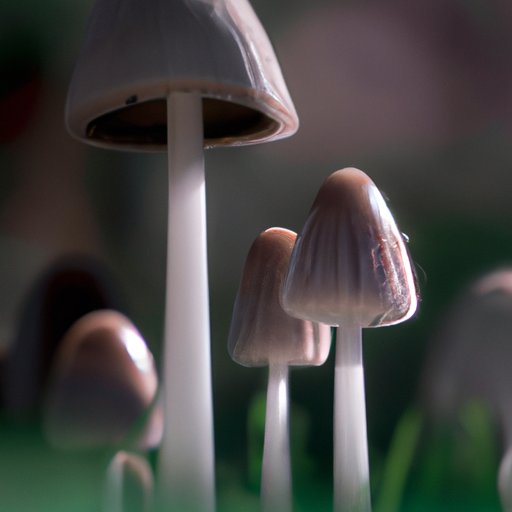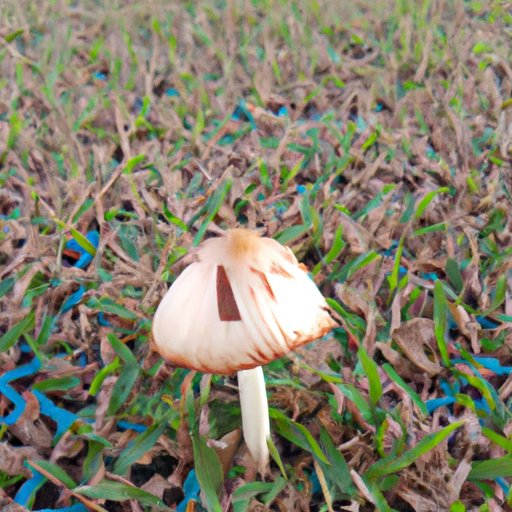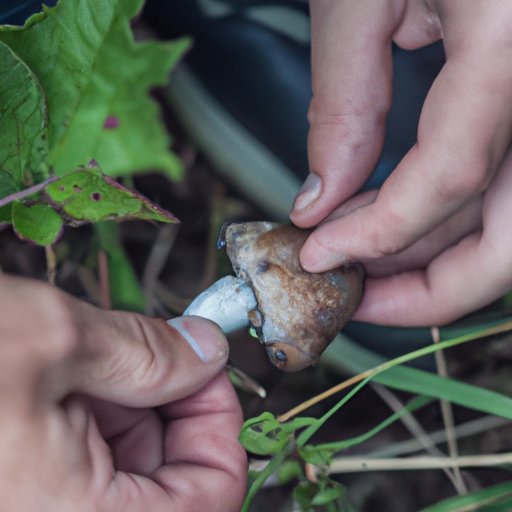Introduction
Hallucinogenic mushrooms, also known as psychedelic mushrooms or “shrooms”, are mushrooms that contain psychoactive compounds which can produce altered states of consciousness, including hallucinations and visual changes. There are several species of mushrooms that can get you high, each with its own unique effects. In this article, we will explore the different types of mushrooms that can get you high, the science behind how they affect the brain and body, the potential health risks associated with using them, and a comparison of the most popular varieties.

The Science Behind How Mushrooms Get You High
The active compound in mushrooms that get you high is called psilocybin, a naturally occurring hallucinogen found in certain species of fungi. When ingested, this compound is metabolized into the active form of psilocin, which binds to serotonin receptors in the brain and produces the psychedelic effects associated with mushrooms. The effects of psilocybin can vary depending on the dose, the type of mushroom consumed, and individual factors such as body weight, metabolism, and mental state.
The effects of psilocybin typically begin within 20 to 40 minutes after ingestion, and can last for up to six hours. Common effects include altered perception of time, visual and auditory hallucinations, enhanced imagination, and feelings of euphoria. At higher doses, users may experience spiritual revelations and insights, out-of-body experiences, and intense emotions.

The Health Risks Associated With Using Hallucinogenic Mushrooms
As with any psychoactive substance, there are potential health risks associated with using hallucinogenic mushrooms. Short-term side effects can include nausea, vomiting, increased heart rate, increased blood pressure, dizziness, confusion, muscle weakness, and feelings of panic or anxiety. Long-term health risks may include flashbacks, persistent psychosis, and increased risk of suicide.
It is important to note that there have been no reported deaths from taking psilocybin mushrooms, but it is still important to be aware of the potential risks and take steps to minimize them. This includes avoiding taking mushrooms in large doses, refraining from driving or operating heavy machinery while under the influence, and always having a sober person nearby who can provide assistance if needed.
A Beginner’s Guide to Finding and Consuming Psychedelic Mushrooms
If you are interested in trying hallucinogenic mushrooms, there are a few things to consider before doing so. First, it is important to know where to find them. While psychedelic mushrooms do grow wild in some parts of the world, they are usually difficult to find and identify correctly. Therefore, it is generally recommended to purchase them from a reputable source.
Once you have procured the mushrooms, it is important to know how to prepare and consume them correctly. Most people choose to eat them raw, though some prefer to dry them out first. If eating them raw, make sure to chew them thoroughly to ensure proper absorption. Alternatively, they can be cooked into food or steeped into a tea. It is important to experiment with different doses and methods to find what works best for you.

How to Identify Hallucinogenic Mushrooms
Identifying psychedelic mushrooms can be challenging due to their similarity to other species of mushrooms. To avoid misidentification, it is important to familiarize yourself with the physical characteristics of the different types of mushrooms that can get you high. Common features to look for include a conical cap, gills, and a white spore print.
It is also important to be aware of common misidentifications. Some poisonous mushrooms can look very similar to psychedelic mushrooms, so it is essential to research the species you are looking for and double-check your identification before consuming them.
The History of Hallucinogenic Mushrooms in Human Culture
The use of hallucinogenic mushrooms dates back thousands of years. Evidence of prehistoric mushroom use has been found in ancient cave paintings, and many early cultures used them in religious ceremonies and rituals. In modern times, psychedelics have become increasingly popular in Western countries, especially among young people.
Today, the use of hallucinogenic mushrooms is growing in popularity, both recreationally and spiritually. Many people believe that these substances can help open up new ways of thinking, enhance creativity, and lead to profound insights and revelations.
A Comparison of Different Types of Mushrooms That Can Get You High
There are several species of mushrooms that can get you high. Some of the most popular varieties include Psilocybe cubensis, Amanita muscaria, and Panaeolus cyanescens. Each type has its own unique effects, so it is important to do your research before trying them.
Psilocybe cubensis is one of the most commonly available types of psychedelic mushrooms. It is known for producing strong visual and auditory hallucinations, along with feelings of euphoria and insight. Amanita muscaria, also known as fly agaric, is another popular variety that is known for producing milder effects than other types of mushrooms. Finally, Panaeolus cyanescens is a more potent variety that is known for producing intense visual and auditory hallucinations.
Conclusion
In conclusion, there are several types of mushrooms that can get you high. It is important to understand the science behind how they work, the potential health risks associated with using them, and how to identify them correctly. Additionally, it is important to be aware of the history of hallucinogenic mushrooms in human culture and the cultural taboos surrounding their use. For those who choose to use them, it is important to start slow and experiment with different doses and methods to find what works best for you.
(Note: Is this article not meeting your expectations? Do you have knowledge or insights to share? Unlock new opportunities and expand your reach by joining our authors team. Click Registration to join us and share your expertise with our readers.)
